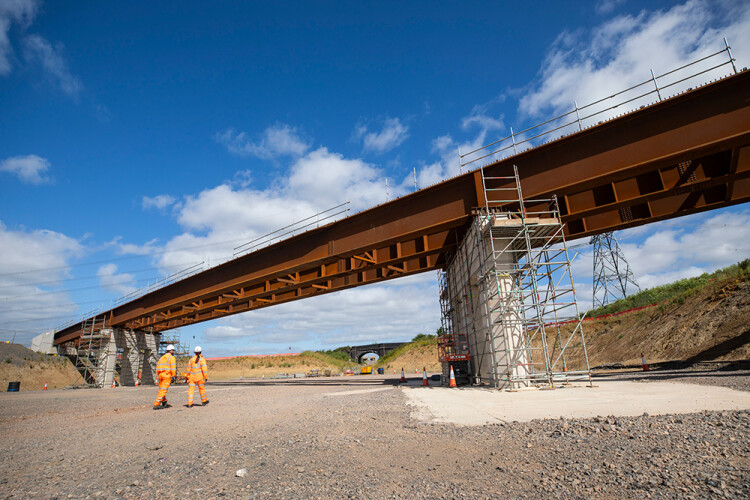Steelwork fabricators report that projects in the pipeline are currently being slowed down by the introduction of the Building Safety Act. But they are hoping that this might be offset by new markets and the incoming government’s commitment to planning reform, health and education facilities.
Better times are around the corner, according to forecasts from the British Constructional Steelwork Association (BCSA) but 2024 is proving challenging. Consumption is predicted to be down by almost 5% compared to last year, making a significant dent in what was close to a 900,000-tonne market.
Although this is nothing compared with the Covid-induced drop of 20% in 2020, (which by now has largely been recovered) BCSA deputy chief executive David Moore says that some members are struggling. “There are some large projects that are going ahead but they have a long gestation period. Projects are not coming through at the rate that we expect them to, and one of the reasons for this is the issues that came out of Grenfell resulting in the introduction of the Building Safety Act,” he says. “That is tending to delay the process.”
Members are also finding that prices are very poor, he reports, although they agree with BCSA’s projection that the market will rebound slightly in 2025 and 2026, by 1% and 1.7% respectively according to its figures.
This year the UK steel market’s total volume is projected to be approximately 850,000 tonnes, a big drop from the 2022 peak of 894,000 tonnes that had held up through 2023. Of this, the vast majority – some 422,000 tonnes – is consumed by the industrial sector, including the large-scale distribution facilities for retailers such as Amazon and M&S.
BCSA expects this sector to shrink by 6.3% compared to last year but it will return to form with new demand in the pipeline. In May this year, Amazon announced plans to invest £500m in building an enormous fulfilment centre next to the M1 in Northamptonshire after a two-year hiatus on construction.
“The biggest sector is the mega-sheds that you see along the motorway,” explains Moore. “Although it has come down quite a way, the expectation is that with gigafactories for batteries and so on going ahead, that will actually increase next year and the year after.”
In July, battery manufacturer Agratas announced the appointment of Sir Robert McAlpine as main contractor for its 244,710m2 GEA battery manufacturing facility that is being built near Bridgwater in Somerset and is due to open in 2026.

Meanwhile the office sector is not falling away as might be expected, given that more people are now working from home. “You would expect demand in the office market to fall, but that’s not quite the case,” says Moore.
“Pre-pandemic we were looking at about 100,000 tonnes, now it is 90,000 tonnes; we had expected it to drop further, but clients are trying to get people back into offices – if not full time, then at least more than just once or twice a week. For that you need offices that provide a range of facilities so it’s not just desk space, it’s gyms and games rooms and so on that they need to tempt people back,” Moore says.
The overall drop in the market is down to a number of issues all wrapped up together, explains BCSA chief executive Jonathan Clemens: “First is Grenfell and the impact that’s had with the introduction of the Building Safety Act, certainly for our larger members. Equally there’s an acceptance that interest rates are part of it. The finance houses have certainly been watching interest rates keenly; larger companies are living on work that has been in the pipeline for a while but they are now seeing a dip. It’s that lag between getting sign-off on new work and getting onto a building site. Everyone is looking forward to 12 months’ time when they think it will be better,” he adds.
The biggest unknowns at the moment are the publicly-funded sectors, says Clemens; he expects it won’t be possible to have any proper insight into this market until this autumn at the earliest, when the new government has properly bedded in. But he says there is ‘lots of hope’ that this market will increase and an expectation that it will be better.
“There is lots of talk about housing at the moment but unless it’s mixed-use city centre residential, our share of that market is very small,” he says. Initial prospects for infrastructure spending on transport, energy, healthcare and education may well have been dampened by subsequent announcements and talk of ‘hard choices’ to address the ‘financial black hole’.
But some companies do have healthy balance sheets. In April Billington announced a record financial performance for 2023, with revenue up just over 50% to £133m and pre-tax profit more than doubled from £5.8m to £13.4m.
Its performance was driven by increased market share and efficiency improvements enabling increased capacity and higher margins, according to chief executive Mark Smith. He pointed to high value contracts across a variety of sectors including manufacturing, data centres, energy from waste, distribution and commercial office developments.

Steelwork fabricator Severfield also posted financial results in June showing another strong performance. Profits were ahead of expectations, although turnover for the year to 30th March 2024 was down 6% at £463.5m from £491.8m the previous year and pre-tax profit fell by 15%, from £27.1m in the year to March 2023 to £23m this time.
Despite a softening in market conditions, Severfield had maintained a strong order book with £478m of contracts secured in the UK and another £181m of work in India, where Severfield has a joint venture with local fabricator JSW Steel.

Severfield has enjoyed strong growth in recent years thanks to major contracts on high-profile projects such as Hinkley Point C nuclear power station and the new Everton FC stadium.
But Clemens says that the number of insolvencies in the industry has increased to ‘record levels’, and that number could increase as a result of the latest dip.
One of the most recent casualties was the award-winning steel fabricator SH Structures, which went into administration in April. The company had high-profile expertise in specialist bridges and complex architectural structures – including the Kelpies sculpture in Falkirk – and employed 70 staff at its works in Sherburn-in-Elmet in West Yorkshire.
At least a dozen of the company’s staff were subsequently taken on by Billington.
Billington chief executive Mark Smith said that his firm would use the acquisition of these specialist skills to move into the bridge market, bringing together its Tubecon business, its steel plate processing skills at Shafton Steel Services and specialist protective coatings capability of Orrmac Coatings, another administration buyout from two years ago.
The slowdown in the market comes at a time when companies are keen to invest further in automation and explore the use of robotics to improve efficiency and pursue the consistency and quality in products that customers value.
“There has already been a significant investment in digital among our members, because of the fact that BIM models are now widely used,” says Clemens. “Likewise, automation has been in place across most of the industry for some years, but there is now an acceptance that robotics needs to play a part going forward. Use of such technologies is now going beyond cutting and drilling, into welding – partly because customers are looking for consistency in the application of welds, and also partly to address the skills shortages in the industry,” he adds.

Part of the challenge is accessing finance. Clemens says: “Our members are mostly SMEs, a number of them are growing entrepreneurs, and they are expected to spend X-million on robots and automated lines.” The challenges of the sector are not really understood by financial institutions and as a result BCSA’s members don’t have easy access to finance, he says.
Lancashire-based fabricator Taziker, which last year benefited from new investment from the company’s original founders, has spent £1m on a new steel fabrication shop in Blackburn, which doubles its capacity and will be used for heavy steel fabrication in support of structural steel infrastructure projects across the UK.
Its new facility has more than 100,000 sq ft of fabrication capacity and overhead cranes rated at 80 tonnes. The company’s most recent accounts reported a turnover of almost £73.5m and a pre-tax profit of £5.1m in the year ending March 2022.
Meanwhile Billington Structures has invested in a 30kW fibre laser machine that is around seven times faster at cutting steel than traditional methods such as plasma and oxy-acetylene plate cutting machines. The new laser machine can cut dense materials such as carbon steel up to 80mm thick and stainless steel up to 90mm.
Greater versatility and higher precision, with less waste and less maintenance, are additional benefits and the fact that the process is non-contact also increases production speed. The machine will replace two existing units, contributing to the company’s efforts to reduce carbon emissions.
Sustainability and the carbon reduction challenge are high on the agenda for all of BCSA’s members, says Moore, although this is another call on financial resources. “Lots of them are putting measures in place to reduce their own carbon footprint – from installing wind turbines to simple things such as changing to low energy light bulbs, or systems that turn off electrical equipment when it’s not in use, for example.”
But he acknowledges that this will have a limited impact overall. “With scope 3 questioning, everyone now needs to know not only their own, but also their suppliers’ carbon footprint. Clearly with steel, the biggest carbon footprint is from the making of the steel itself – so we welcome announcements from British Steel and Tata about their plans to move from basic oxygen steelmaking to electric arc furnaces,” adds Moore.
While ease of recycling has long been promoted as a benefit of steel, there is growing interest in a reuse market, confirms Moore. “Companies are looking to get more into it to improve their sustainability credentials, and there have been a number of projects in London where the client has driven that decision.”
Some of the steel beams and columns being reused were rolled in the 1920s, he says, and BCSA has archive information on all types of steel that have been produced since the 1890s. “A week doesn’t go by without me getting a phone-call from someone saying they are taking a building down and asking for the sectional properties of certain steel beams marked as being made by Redpath Dorman Long, for example,” Moore says.

Got a story? Email news@theconstructionindex.co.uk



